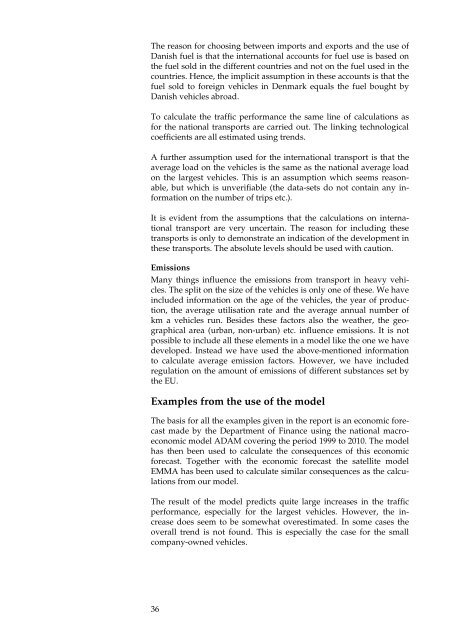En model for godstransportens udvikling - DCE - Nationalt Center for ...
En model for godstransportens udvikling - DCE - Nationalt Center for ...
En model for godstransportens udvikling - DCE - Nationalt Center for ...
You also want an ePaper? Increase the reach of your titles
YUMPU automatically turns print PDFs into web optimized ePapers that Google loves.
The reason <strong>for</strong> choosing between imports and exports and the use of<br />
Danish fuel is that the international accounts <strong>for</strong> fuel use is based on<br />
the fuel sold in the different countries and not on the fuel used in the<br />
countries. Hence, the implicit assumption in these accounts is that the<br />
fuel sold to <strong>for</strong>eign vehicles in Denmark equals the fuel bought by<br />
Danish vehicles abroad.<br />
To calculate the traffic per<strong>for</strong>mance the same line of calculations as<br />
<strong>for</strong> the national transports are carried out. The linking technological<br />
coefficients are all estimated using trends.<br />
A further assumption used <strong>for</strong> the international transport is that the<br />
average load on the vehicles is the same as the national average load<br />
on the largest vehicles. This is an assumption which seems reasonable,<br />
but which is unverifiable (the data-sets do not contain any in<strong>for</strong>mation<br />
on the number of trips etc.).<br />
It is evident from the assumptions that the calculations on international<br />
transport are very uncertain. The reason <strong>for</strong> including these<br />
transports is only to demonstrate an indication of the development in<br />
these transports. The absolute levels should be used with caution.<br />
Emissions<br />
Many things influence the emissions from transport in heavy vehicles.<br />
The split on the size of the vehicles is only one of these. We have<br />
included in<strong>for</strong>mation on the age of the vehicles, the year of production,<br />
the average utilisation rate and the average annual number of<br />
km a vehicles run. Besides these factors also the weather, the geographical<br />
area (urban, non-urban) etc. influence emissions. It is not<br />
possible to include all these elements in a <strong>model</strong> like the one we have<br />
developed. Instead we have used the above-mentioned in<strong>for</strong>mation<br />
to calculate average emission factors. However, we have included<br />
regulation on the amount of emissions of different substances set by<br />
the EU.<br />
Examples from the use of the <strong>model</strong><br />
The basis <strong>for</strong> all the examples given in the report is an economic <strong>for</strong>ecast<br />
made by the Department of Finance using the national macroeconomic<br />
<strong>model</strong> ADAM covering the period 1999 to 2010. The <strong>model</strong><br />
has then been used to calculate the consequences of this economic<br />
<strong>for</strong>ecast. Together with the economic <strong>for</strong>ecast the satellite <strong>model</strong><br />
EMMA has been used to calculate similar consequences as the calculations<br />
from our <strong>model</strong>.<br />
The result of the <strong>model</strong> predicts quite large increases in the traffic<br />
per<strong>for</strong>mance, especially <strong>for</strong> the largest vehicles. However, the increase<br />
does seem to be somewhat overestimated. In some cases the<br />
overall trend is not found. This is especially the case <strong>for</strong> the small<br />
company-owned vehicles.<br />
36

















